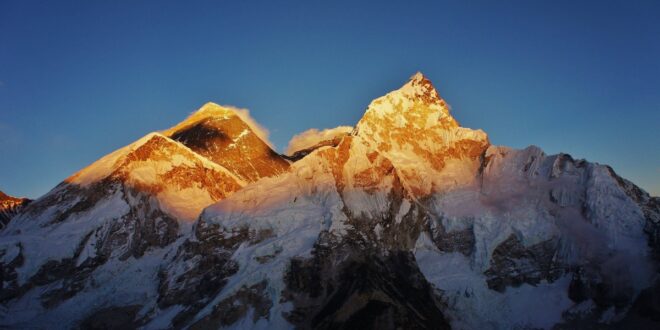
Question:
How Much Earlier is Sunrise on Mount Everest Due to Elevation?
Answer:
The greatest sunrise and sunset elevation effect on Earth is on Mount Everest (at 27.988° N, 86.925° E as seen on the Direction to Yerushalayim Map). With an elevation of 8,848 Meters (29, 029 feet), sunrise would be up to 15 minutes and 31 seconds earlier on Mount Everest than at sea level. The range of the effect is from 15 minutes and 31 seconds on June 22nd, to a “low” of 13 minutes 41 seconds earlier on March 18th. Being in a large mountain range with obstructed horizons, it is likely never actually seen that early. In addition to questions about mountains, every few months I get asked about how much earlier sunrise/set can be seen in skyscrapers. There are various halacha questions as to whether this actually affects zmanim that I will mention later. Here are some raw numbers. 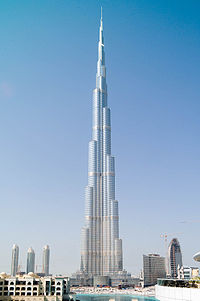 Burj Khalifa (at 25.197° N, 55.274° E as seen on the Direction to Yerushalayim Map) is the tallest building in the world. With a height of 828 m (2,717 ft), visible sunrise to someone standing on top of the crown (something unrealistic) on June 22nd would be at 5:24:56 AM versus 5:29:31 AM on sea level, a difference of 4 minutes and 35 seconds. Sunset would be 7:16:35 PM versus 7:12:00 PM at sea level, a difference of 4 minutes and 35 seconds. A more realistic scenario would be the visibility sunrise on the highest floor (the 160th), an elevation of 672 m (2,204 ft) at 5:25:23 AM, a difference of 4 minutes and 8 seconds earlier than sea level. Sunset on the 160th floor would be 7:16:08 PM, or 4 minutes and 8 seconds later than at sea level.
Burj Khalifa (at 25.197° N, 55.274° E as seen on the Direction to Yerushalayim Map) is the tallest building in the world. With a height of 828 m (2,717 ft), visible sunrise to someone standing on top of the crown (something unrealistic) on June 22nd would be at 5:24:56 AM versus 5:29:31 AM on sea level, a difference of 4 minutes and 35 seconds. Sunset would be 7:16:35 PM versus 7:12:00 PM at sea level, a difference of 4 minutes and 35 seconds. A more realistic scenario would be the visibility sunrise on the highest floor (the 160th), an elevation of 672 m (2,204 ft) at 5:25:23 AM, a difference of 4 minutes and 8 seconds earlier than sea level. Sunset on the 160th floor would be 7:16:08 PM, or 4 minutes and 8 seconds later than at sea level.
As far as the halacha being affected by the elevation of buildings, the Baal Hatanya seems to indicate that tall buildings would make sunset later. See Yisroel vehazmanim ישראל והזמנים Vol II, page 910. In the Shraga Lachaim שרגא לחיים footnotes Rabbi Harfenes states that
ויש להוסיף שהוא דבר תמוה לומר דעד שלא נבנו הבנינים הגבוהים היה זמן שבת התלוי בשקעה”ח (שקיעה ראשונה להגאנים ושקיעה שניה לר”ת) מוקדם, ולאחר שנבנו יש לאחר הזמנים, ועד עכשיו שהיו בניו יארק הבנינים התאומויות (טווין-טאוע”ר בלע”ז) שכל א’ מהם היה בת ק”י קומות היה זמן השקיעה מאוחר, ועתה לאחר שהפילו והרסו אותם רשעים וזדים ארורים ימ”ש חזר הדבר לקדמותו להקדים זמן השקיעה.

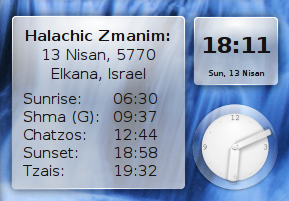 Moshe Wagner recently released ZmanimPlasma for the Linux platform. This KDE Plasma desktop widget displays the Hebrew date and zmanim on a Linux desktop. The zmanim calculations use Moshe’s C++ port Zmanim CLI wrapper that enables a C++ program to call the Java Zmanim API. There are no current plans to make this widget available on any other platform. It can be downloaded from the Luach project download page. Moshe has in the past used the Zmanim API for use in Linux and some cross platform projects. These include the above mentioned Zmanim CLI, and Zmanim GUI that uses the ZmanimCLI.
Moshe Wagner recently released ZmanimPlasma for the Linux platform. This KDE Plasma desktop widget displays the Hebrew date and zmanim on a Linux desktop. The zmanim calculations use Moshe’s C++ port Zmanim CLI wrapper that enables a C++ program to call the Java Zmanim API. There are no current plans to make this widget available on any other platform. It can be downloaded from the Luach project download page. Moshe has in the past used the Zmanim API for use in Linux and some cross platform projects. These include the above mentioned Zmanim CLI, and Zmanim GUI that uses the ZmanimCLI.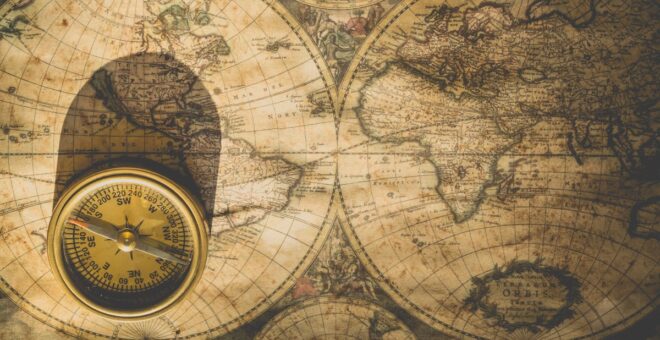 The availability of the
The availability of the 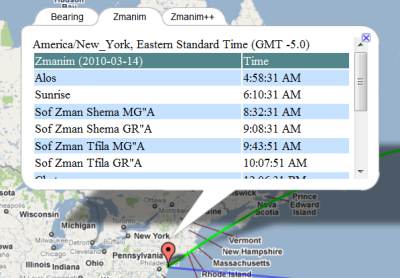 I recently updated the map to look-up the actual timezone of the latitude and longitude selected by the user. This was implemented by doing a look-up at the
I recently updated the map to look-up the actual timezone of the latitude and longitude selected by the user. This was implemented by doing a look-up at the 

 The Zmanim API 1.2 was released today. The only change in this release is the removal of elevation as a factor in the calculation of all zmanim besides sunrise and sunset. Updated
The Zmanim API 1.2 was released today. The only change in this release is the removal of elevation as a factor in the calculation of all zmanim besides sunrise and sunset. Updated